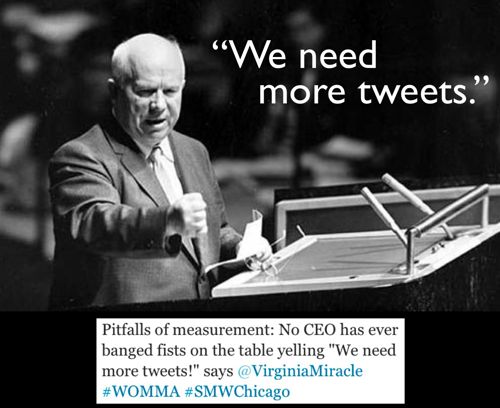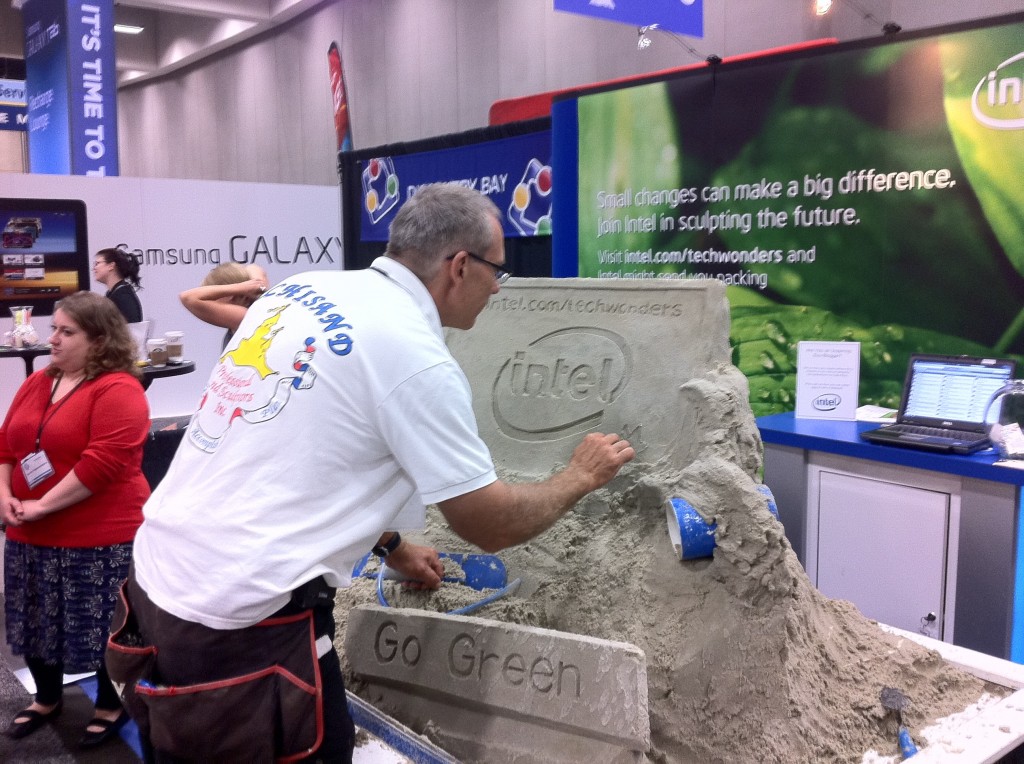We Need More Tweets!
(this cross-posted on Ogilvy’s Fresh Influence blog)

On a panel last week for a WOMMA event at Chicago’s Social Media Week, I had the pleasure of sitting with Keller Fay’s Ed Keller, Brains on Fire’s Robbin Phillips, and Social Media Today’s Robin Carey to discuss social media measurement under the heading of “Is WOM worth it?”. In the context of that discussion, I talked about the siren song of social media counting (vs. measurement) and the trap that we too-frequently see: social media “cases” that end by rattling off 20 different social media metrics that do not track to a meaningful business metric. To illustrate, I mentioned that no CEO is not banging the table looking for more tweets (which BrandAutopsy riffed into the above), he’s looking for shareholder value – sales, market share, preference, purchase intent and a legion of other measures that can not be ripped off the back of Facebook insights.
So, with that in mind and the voices of my esteemed co-presenters in my head, I put together a list of 4 potential measurement pitfalls that can kill your social media measurement program before the horses have left the stable:
1) Setting the wrong objectives. This sounds silly, but often an activity or “client brief” will be mis-translated as an objective. For example, “run a high-impact event” is an activity, but “increase consideration and share of voice among X audience” attending that event is an objective. TEST: Can it be measured? If the answer is no, it isn’t an objective.
2) Determine the meaningful (vs. diagnostic) KPIs before you begin: Chances are, meaningful KPI’s will require measurement techniques beyond simple, spoon-fed social media metrics like likes and shares. Take a walk through our Conversation Impact(TM) white paper to determine how to craft meaningful Reach, Preference, or Action KPIs.
3) Find where your audience is interacting on a relevant topic: Yes, Facebook has 800 million people and likely some of them are in your desired “audience” but they may not be on Facebook to discuss their mother’s prescriptions or whatever topic that you may have value to add. The important second step to “going where the party” is already happening is not just determining where your audience is, but how they are using social media for different things – where do they share recipes vs. look for snowboot recommendations? While they could light up for FB, Twitter, Flickr, etc it will be critical to understand the relevance of those platforms to their lives to put together a measurable strategy.
4) Plan to measure: If you put together a measurement plan after you’ve already begun, you have lost your chance at a baseline and being able to know the true impact of your efforts. Ed Keller admitted that he often gets calls halfway through campaigns at which point, there are limitations on the types of measurements that can be taken. The baseline is going to be the key to your “winning” metric such as “Increased purchase consideration by 45%”. That is the type of metric that CEOs do care about and will keep your social media efforts on strategy and in budget in 2012.

 Andrea Jung is a rockstar. Frankly, anyone who is a CEO of a company of Avon’s social and financial importance for more than a decade would be. Yesterday, I saw her give a public address on leadership to an audience of largely women. She was down to earth, inspiring, and highly quotable. A few of my takeaways and their applicability to social media below:
Andrea Jung is a rockstar. Frankly, anyone who is a CEO of a company of Avon’s social and financial importance for more than a decade would be. Yesterday, I saw her give a public address on leadership to an audience of largely women. She was down to earth, inspiring, and highly quotable. A few of my takeaways and their applicability to social media below: Whenever you get to the point of splitting platform responsibility between different departments, you run the risk of creating a new set of silos. 6 months in, you may find your boss praising what you’re doing in LinkedIn and questioning the way Facebook is being run. You may read something posted on Twitter and realize it would have been perfect for you to capture video around for the YouTube & Facebook audience if only you’d known! Here are 5 suggestions to systematize collaboration and prevent those silo walls from re-growing around you:
Whenever you get to the point of splitting platform responsibility between different departments, you run the risk of creating a new set of silos. 6 months in, you may find your boss praising what you’re doing in LinkedIn and questioning the way Facebook is being run. You may read something posted on Twitter and realize it would have been perfect for you to capture video around for the YouTube & Facebook audience if only you’d known! Here are 5 suggestions to systematize collaboration and prevent those silo walls from re-growing around you: